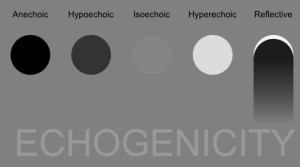

MedFriendly®


Echogenic
Echogenic means pertaining to a structure (such as a
tissue) that has echoes inside of it. These echoes are
displayed with techniques (broadly referred to as
ultrasound scanning) that use sound waves to produce
pictures. The sound waves bounce off internal body
parts and reflect back as an echo to a computer, which
produces an image. An example of such an ultrasound
technique is echocardiography, which uses types of
sound waves to produce pictures of the heart.
FEATURED BOOK: Ultrasound Scanning: Principles and Procedures
This can reveal a condition known as an echogenic cardiac focus, which refers to a high
number of echoes inside an area of an unborn child’s heart. Structures that produce
echoes on ultrasound appear as varying shades of gray. Specifically, body structures
that are less reflective and produce a lower amount of echoes are known as hypoechoic
and appear as darker shades of gray. Conversely, body structures that are more
reflective and produce a higher amount of echoes are known as hyperechoic and appear
as lighter shades of gray.
The opposite of echogenic is anechoic, which means being without an echo or appearing
without echoes. Echogenic comes from the Greek word "echo" meaning "sound," the
Greek word "genos" meaning "birth," and the Greek word "ikos" meaning "pertaining to."
Put the words together and you have "pertaining to (the) birth (of) sound."
"Where Medical Information is Easy to Understand"™















